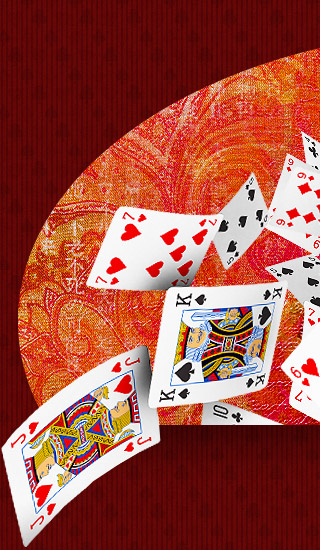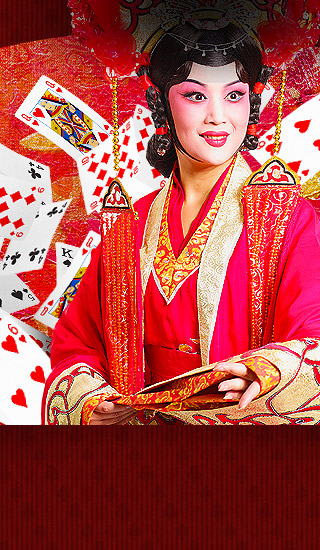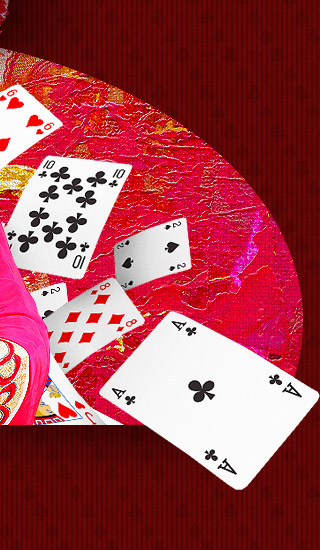Chuo Dai Di Card and Hand Rank
In all poker variations and in most card games, the Ace is the highest card while the Two is the lowest. But in Chuo Dai Di, the Two is the highest card and the Three is the lowest.
Here's the rank of cards from highest to lowest:
2 - A - K - Q - J - 10 - 9 - 8 - 7 - 6 - 5 - 4 - 3
The suit of the card also matters in Chuo Dai Di. Here's the rank of suit from highest to lowest:
 Diamond
Diamond Clubs or Clover
Clubs or Clover Hearts
Hearts Spades
Spades
Thus, a player with an Ace of Diamond beats a player with an Ace of Hearts.
Here's the rank of five-card combinations or hands from highest to lowest:
Royal Flush - a straight flush from the Ten to the Ace.
Example: 10
10  J
J  Q
Q  K
K  A
AStraight Flush - five consecutive cards of the same suit.
Example: 3
3  4
4  5
5  6
6  7
7Four of a kind (or quads) - four cards of one rank, plus any fifth card (or kicker).
Example: A
A  A
A  A
A  A
A  K
KFull House - three cards of one rank plus a pair of another rank.
Example: K
K  K
K  K
K  2
2  2
2Flush - any five cards of the same suit.
Example: 2
2  7
7  10
10  K
K  A
AStraight - five cards of consecutive rank in mixed suits.
Example: 8
8  9
9  10
10  J
J  Q
Q
Here are a few more rules to follow in playing five card combinations:
A straight with higher ranks beats a lower one, regardless of the suits of the cards. But when the rank of all the five cards is the same, the suit of the top card determines which is higher.
For example  K
K  Q
Q  J
J  10
10  9 beats
9 beats  Q
Q  J
J  10
10  9
9  8, which, in turn beats
8, which, in turn beats  Q
Q  J
J  10
10  9
9  8.
8.
Also, twos do not rank high in straights, but below the 3, so the highest straight is A-K-Q-J-10 including the ace of spades. Aces can be counted as low to make the lowest type of straight 5-4-3-2-A, which is beaten by 6-5-4-3-2 and 7-6-5-4-3. An ace can be used at either end of a straight, but not in the middle, so collections like 3-2-A-K-Q or 2-A-K-Q-J are not valid straights (but there are variations on this rule).
Meanwhile, a flush in a higher suit beats a flush in a lower suit, regardless of the ranks of the cards. Between two flushes in the same suit, the one with the higher top card is better. Example:  9
9  7
7  6
6  5
5  3 beats
3 beats  2
2  J
J  9
9  6
6  4, which beats
4, which beats  A
A  K
K  Q
Q  10
10  7.
7.
Between two full houses, the one whose triple is of higher rank is beats the one with the lower triple. For example, 9-9-9-4-4 beats 8-8-8-K-K.
In a four of a kind, the fifth card must be included. Four equal cards alone is not a playable hand. Between two fours of a kind, the rank of the four cards determines which is higher.
In straight flushes, the rank of the highest card determines which of two straight flushes is higher; between two equal ranked straight flushes, the one in the higher suit is better, so 2 3 4 5 6 beats 2 3 4 5 6.
域名 chuodaidi.com 正在出售中,如果您对该域名感兴趣,请点击这里提供您的报价。
The domain name chuodaidi.com maybe for sale. Please click here if you would like to make an offer.



